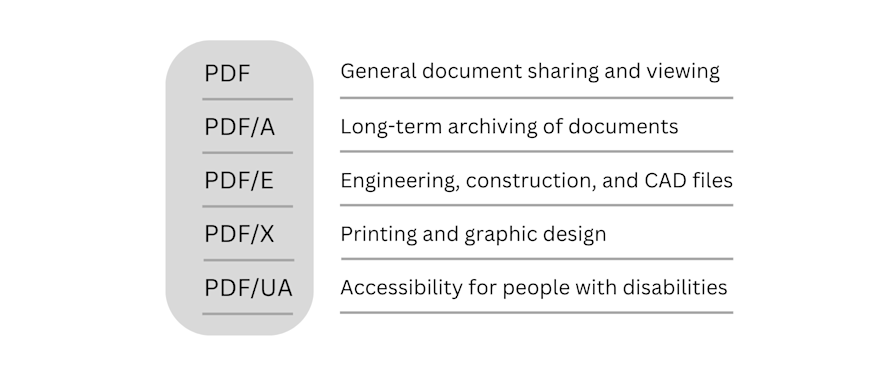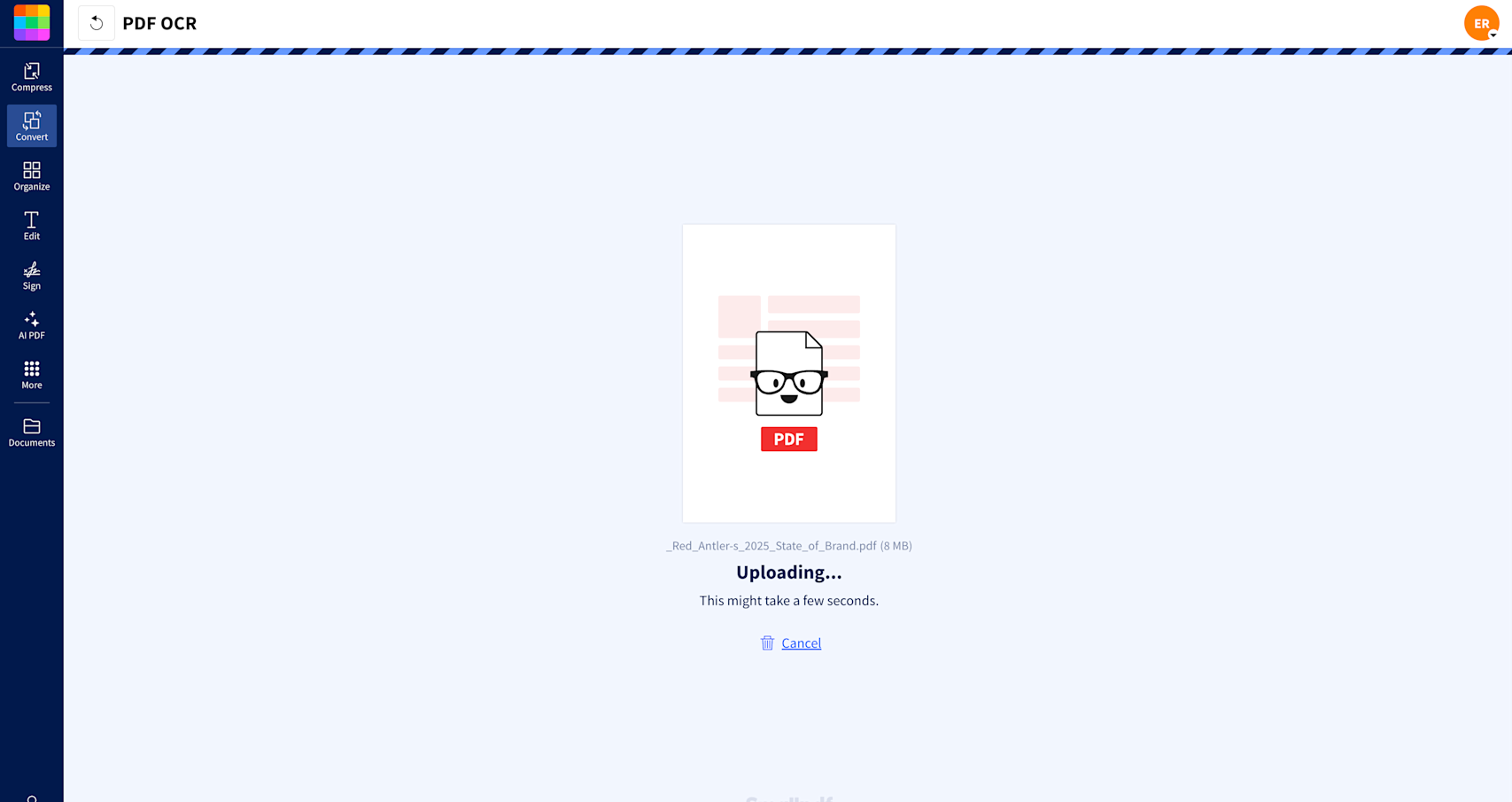
Understanding the Different Types of PDF Files: A Comprehensive Guide
by Stéphane Turquay
Do you know your PDF types? Here, we break them down—PDF, PDF/A, PDF/E, PDF/X, PDF/UA—and help you find the right PDF format for your needs.
Do you know your PDF types? Here, we break them down—PDF, PDF/A, PDF/E, PDF/X, PDF/UA—and help you find the right PDF format for your needs.
PDFs are the gold standard for sharing and preserving digital documents. But not all PDFs are created equal.
From long-term archiving to high-quality printing, different types of PDFs are designed for specific needs. Understanding these formats can help you choose the right PDF type for your project—whether it’s a business report, a legal document, marketing materials, or something else.
In this guide, we walk through the different PDF document types: PDF, PDF/A, PDF/E, PDF/X, and PDF/UA. You’ll learn about their unique features, searchable PDFs, and which PDF format is best for your needs.

1. Standard PDF: For Everyday Tasks
When most people think of a PDF, they’re imagining the standard format. It’s the go-to choice for sharing and viewing documents because it preserves formatting across all devices and platforms.
Standard PDFs support multimedia, hyperlinks, and interactive elements, making them useful and versatile for everyday tasks.
Use Cases:
- Sharing resumes, reports, or presentations.
- Documents requiring interactive elements like forms or links.
- Everyday business or personal use.
Advantages:
- Compatible with all devices and software.
- Easily editable with the right tools.
- Supports multimedia and form fields.
Limitations:
- Not ideal for long-term preservation due to potential compatibility issues with future software updates.
PDFs are built to preserve their formatting, but you can still make changes. You can edit your PDFs, annotate them, and update the files in lots of ways. Even better, you can do it for free with no software downloads with Smallpdf. Want to try?
2. PDF/A: Built for Archiving
What is PDF/A? The “A” stands for “Archival,” and it’s the go-to format for long-term document preservation.
PDF/A ensures that every component of the file—fonts, images, and colors—is embedded directly into the document, so you can access it even decades from now. But it comes at a small cost. To enable long-term preservation, PDF/A restricts features like multimedia, encryption, and hyperlinks, which might not be supported in the future.
Use Cases:
- Archiving legal, governmental, or historical records.
- Preserving contracts, wills, and other personal documents.
- Any scenario where long-term accessibility is critical.
Advantages:
- Ensures documents can be opened in the future without compatibility issues.
- ISO-standardized, making it widely accepted for official archiving.
Limitations:
- Doesn’t allow for interactive elements like multimedia, hyperlinks, or fillable forms.
If you work with contracts, records, or other documents that require long-term archiving, have a look at our beginner’s guide to working with PDF/A documents.
3. PDF/E: Optimized for Engineering
What is a PDF/E file? The PDF/E format is optimized for large, complex files like CAD drawings and 3D models. It also supports layers, transparency, and embedded multimedia for enhanced visualization. This makes it a perfect format for the engineering and construction industries.
Use Cases:
- Sharing technical drawings, blueprints, and schematics.
- Collaborating on construction or manufacturing projects.
- Visualizing 3D models.
Advantages:
- Handles large, detailed files with ease.
- Ideal for technical and engineering industries.
Limitations:
- Less widely used outside of engineering and construction.
4. PDF/X: The Printing Standard
PDF/X is the best PDF format for printing. It guarantees accurate color reproduction and layout. It does this by embedding fonts and images to eliminate issues during printing.
Use Cases:
- Creating print-ready brochures, posters, or booklets.
- Ensuring consistent output for marketing materials.
Advantages:
- Guarantees precise color and layout for printed materials.
- ISO-standardized, making it a trusted choice for print professionals.
Limitations:
- Not suitable for interactive documents or online use.
Do you have multiple documents to send to the printer? Make it even easier by merging your PDFs into a single file. You can combine multiple PDFs using Smallpdf’s free online Merge PDF tool.
5. PDF/UA: Enhancing Accessibility
PDF/UA (Universal Accessibility) is designed to make documents accessible to individuals with disabilities. It’s compatible with screen readers and other assistive technologies, meeting accessibility standards, like WCAG, to make digital content accessible to people with disabilities.
Use Cases:
- Creating accessible eBooks, reports, or educational materials.
- Complying with accessibility regulations for public-facing documents.
Advantages:
- Enhances inclusivity and usability.
- Meets legal accessibility requirements in many regions.
Limitations:
- Requires additional effort to meet accessibility standards.
Working With Searchable PDFs
Many people ask what PDF type is searchable. In reality, being able to search a PDF isn’t about the PDF document type, it’s about how the PDF was created.
When documents are scanned, for example, the text in the document comes out like a flat picture rather than lines of text that you can search and select.
The good news is that you can make your PDF searchable using optical character recognition (OCR) technology.
The even better news is that you can quickly create searchable PDF files using free tools like Smallpdf’s PDF OCR here.

How To Choose the Right PDF Format
When deciding which PDF format to use, start by asking: What is the best PDF to use for my project? Think about your goals, then select the right type of PDF for you:
- General Use - Stick with the standard PDF format for day-to-day needs.
- Archiving - Go with PDF/A for reliable, long-term preservation.
- Engineering Projects - PDF/E is your best bet for detailed technical drawings.
- Printing - Opt for PDF/X to ensure print accuracy.
- Accessibility - Use PDF/UA to make your content more inclusive.
Or to sum it up a different way, here’s what each format is best used for:
- PDF - Everyday tasks like emailing documents and sharing presentations.
- PDF/A - For archiving legal documents, contracts, and government or personal records.
- PDF/E - For sharing CAD files, blueprints, or technical specifications.
- PDF/X - For creating print-ready materials like brochures, posters, and marketing assets.
- PDF/UA - For eBooks, reports, or public-facing documents with accessibility standards.
How can you tell what type of PDF you have? If you’re unsure about the PDF type you’re working with currently, you can check the file’s metadata. You can find this by checking the properties in most PDF readers. Or on a Mac, by clicking Tools > Show Inspector.
Once you’ve got the right PDF format for your project, remember you’ve got plenty of options to enhance your documents.
If you want to make your PDFs even more useful, Smallpdf offers tools to edit, convert, and optimize PDFs for any purpose. You can try it online for free, with no downloads and no commitment.



